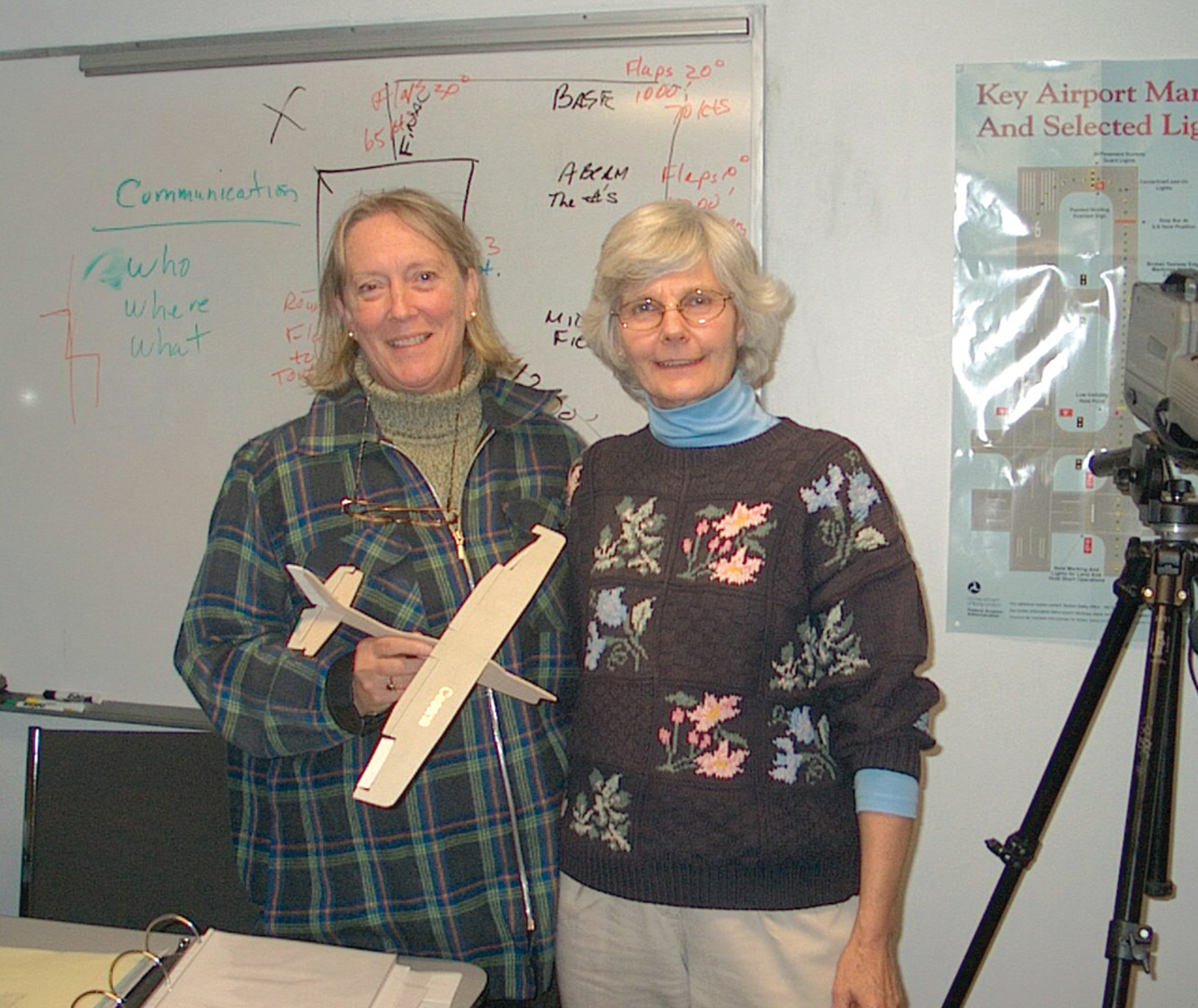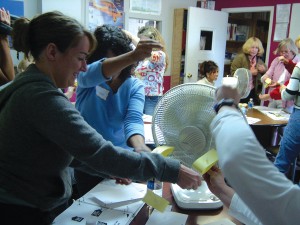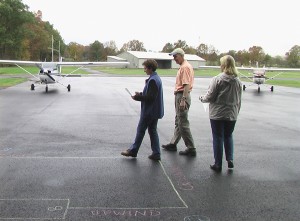By Henry M. Holden
In the world of aviation, as in many industries, women are underrepresented. Several reasons have been put forth as to why out of 600,000 licensed pilots only about six percent (roughly 36,000) are women. One reason given is economics; often, women earn less in the marketplace and can’t afford flight lessons. Another reason is discrimination.
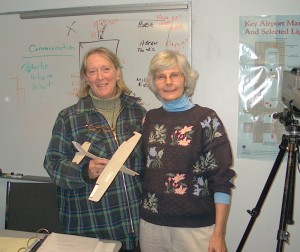
Lindner Castner (left) teaches the ground school portion of the workshop. Dr. Sue Stafford brought some important research on adrenalin-rich environments to the workshop structure.
Linda Castner and her brother, Bill Fritsche, co-own a fixed base operation, Alexandria Field, Inc., at Alexandria Airport, a small airfield in Pittstown, N.J. (Hunterdon County), built by their father in 1944. Castner, a current private pilot and advanced ground instructor, learned to fly at an early age. She made some interesting observations while running the FBO.
At times, she offered the wives of student pilots a free ride in the back seat, only to have the offer turned down. She thought at first that it was the fear of flying, creating the fear of dying, but she wasn’t sure. Castner, who has a MS in exercise physiology and taught physical education at Bryn Mawr College for 11 years, decided to do some research.
First, she conducted formal interviews with more than 100 female pilots. She discovered it’s the rare woman who takes to flying on her own. The majority of women who become pilots do so because of a strong emotional connection with a male—father, brother, husband, boyfriend or friend.
She then conducted informal interviews with hundreds of women who don’t fly, but visited Alexandria Field with husbands or male friends who were taking flight lessons. Women who don’t fly appeared to have deeper issues; they were fearful, but not of dying, although that does enter into the picture sometimes.
Castner was able to put her data into three categories: psychological, social/cultural and physical. On the psychological side, many women feared they weren’t smart enough. On the social/cultural side, Castner discovered they had learned a lot of misinformation, such as, “It’s a man’s thing; women shouldn’t fly.” Parents felt guilty, believing, “Mothers shouldn’t take risks, whether it’s riding a horse or flying an airplane; my children need me.” On the physical side, women felt they lacked the coordination needed, or weren’t athletic enough. The work was too mechanical, or too greasy. A few, though, did voice a fear of dying.
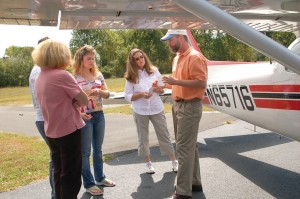
Rich Stowell, FAA 2006 CFI of the Year, is the chief pilot for the workshops. Stowell earned the country’s first master instructor aerobatic rating.
Castner now had some valuable data and decided to come up with a way to use her experience to empower more women to consider aviation. She wanted other women to be able to experience the power of flight.
“I decided to do four workshops and test my theories about why women did and didn’t fly,” she said.
With the assistance of a New Jersey aviation education grant, she designed a two-day workshop geared toward leading women on a path of self-discovery. She used the flying experience as a vehicle, and introduced techniques she’d studied and used as a teacher. She built into the workshops the psychology of performance and some mind/body/spirit connections (the emotional piece).
“There were things I had to better understand before I began,” she said. “I needed to learn more about psychology, and the trust relationship with the instructor. I also didn’t understand the way women perceive themselves when they go out to fly. I developed a ‘play with a purpose’ module and a series of experiential activities, and mixed them with the metaphors of flying.”
Each participant would also fly twice each day in a Cessna 172, 30 minutes in the front seat and 30 minutes in the back seat. By learning to fly in a controlled environment, she believed that women would discover their strengths and become empowered. Castner offered the workshop four times, to 21 women, between May 2001 and November 2002. The student population was random, and the only common trait among them was that most were afraid to fly, and they all had been misinformed about flying.
The results were tremendously positive. One hundred percent of the women reported feeing empowered by the experience of flying an airplane. A comment typically made by a majority of attendees was that the workshop had been a catalyst for “realizing how powerful doing physical activity with risk can impact your confidence level.”
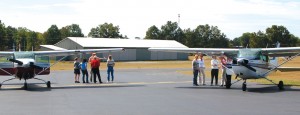
Frank Heffernan teaches an experiential exercise to learn the traffic pattern. Heffernan has earned awards including: the New Jersey Governor’s Medal (1997), and a Distinguished Teacher Award from Princeton University (2001).
Excited by the informal research results, Castner was sure the workshop experience was important, especially to women who had little or no interest in flying. She decided to conduct a more formal research study using her previous workshops as a foundation. Then, she partnered with Dr. Sue Stafford, a private pilot who was land and sea instrument rated. Stafford holds a PhD and teaches philosophy at Simmons College in Boston.
The two women restructured the original workshops as a research project and received a grant from the Wolf Aviation Fund to support their research. They carefully devised the research question, “Is there a connection between perceived risk-taking and the development of self-reliance in women?”
The phrase “perceived risk-taking” was used because risk is complex. One research goal was to learn how those attending workshop perceived the nature of risk. The term “self-reliance” was used because it’s so bland. The goal was to insure that the participants weren’t prompted by certain words in their responses. If women felt empowered, they would have to offer that description without prompting.
“Because of Sue, everything we have in our workshops is solidly based on academics,” said Castner.
Between October 2003 and November 2004, the women ran three workshops, at Simmons College in Boston; Mercer County Community College in Trenton, N.J.; and Western Air Flight Academy in Broomfield, Colo. Twelve women participated in each workshop, which included students, faculty, administrators and businesswomen, ranging in age from 18 to 56. The workshops were also ethnically diverse, and included African Americans, Hispanics, Pakistanis and Japanese.
Questionnaires, journals and group discussions were part of the workshops. The sessions were video and audio-taped to capture the exact words and body language of participants. One month after the workshop, a follow-up question went out to all who had attended: “Have you done anything you would attribute to your workshop experience?” The same question was sent out again six months after the workshop.
The results were impressive. The immediate response of the majority of participants was excitement and a rush to communicate the experience to family, friends and coworkers. Thirty-five out of 36 participants reported an increase in self-confidence. They expressed this result in their own words: self-confidence, self-respect, self-esteem and empowerment.
One person said, “I can always draw on this experience as a reference that I can accomplish things I may feel are far outside the normal boundaries.” Another spontaneously reported that a year and a half after attending the workshop that the experience continued to “always be there.” When she found herself in a challenging work situation, she would just say to herself, “If I can fly an airplane, I can do anything!”
Another significant finding had to do with the nature of perceived risk. While many attendees reported perceiving some physical risk, the risk of dying in a crash and the psychological and social/cultural risk proved to be more significant factors. A significant number of participants reported fear of “being too stupid and feeling foolish.” After flying, most women reported their sense of perceived risk had lessened, and they expressed a more positive attitude toward airplanes and flying.
In reviewing their research results, Castner and Stafford realized that the workshop also led participants to develop three leadership traits: self-confidence, collaboration and adaptability.
Self-confidence is the ability to enter unfamiliar terrain and take action. With 98 percent of women reporting an increase in this leadership trait, the workshop was clearly a powerful tool for leadership training.
“Every woman who came out of there had a high level of self-confidence, and went on to make big changes in her life,” Castner said.
Ninety-one percent of participants demonstrated an improved ability to adapt to conditions that required new learning. One woman remarked that she would be more willing to take chances in her career.
Eighty-one percent of participants came to new understandings about the role and value of collaboration in tackling a difficult and perceived risky task. One woman, feeling fulfilled and exhausted by the first day’s activities, shared her reluctance to attend on the second day of the workshop.
“But knowing I’d have affected 11 other people if I hadn’t shown up made a huge impact on me,” she said.
Attendees were asked specifically about how the workshop affected their sense of self-reliance. Most reported being quite self-reliant at the start of the workshop, but weren’t asked specifically about the three leadership traits. Their responses showed that the three key leadership traits were developed because of the workshop experience. The participants also reported an improved perception of the risks and rewards of flying in small airplanes.
Follow-up to the second set of workshops had women saying, “I’ve gone back to graduate school,” “I’ve learned to drive a car,” “On Friday nights I now leave my dorm room and venture out into the world with my friends.
“We’re still getting comments like these from the people,” Castner said. “They’ve made huge life-affecting changes. Before the last workshop, Sue did a lot of research into the adrenalin effect on people. She discovered that when you learn something in an adrenalin-enriched environment—not a panic situation, but where your emotions are involved—pulse rate quickens, senses are sharper, you sweat a little bit, and you retain the information longer.”
Rather than talking about self-confidence, adapting and collaboration in a classroom, Castner takes them into the cockpit.
“Instead of learning some leadership skill in a didactic classroom situation, if you can learn it in an adrenalin-enriched environment, such as the cockpit, you will retain the ability to make that life-changing connection,” she said. “For example, the two-person teams alternate between the front-seat and back-seat activity. You’re the pilot-in-command or you’re along for the ride. The PIC is the team leader, and her partner is in the back seat.”
By alternating, the person in the back seat can make the connection about what is needed to move into the front-seat position. She will see that it involves respect and cooperation. She learns what is expected from the person in the back seat and can then transition successfully into the front-seat leadership role. Castner sees the workshop as particularly helpful to women in business.
“It’s a perfect kind of academy for upper management, or someone working her way up in middle management,” she said. “I had a person say, ‘I learned more about myself and my abilities as a leader in the two days of the Leaders Take Flight workshop than I did in many past full semester leadership programs.”
Having identified confidence, adaptability and collaboration as key leadership traits that are developed by the workshop experience, Castner and Stafford redesigned the workshop to focus on these traits. In the new workshop, the flying activities have been tailored for the business context, and the discussions focus specifically on the three traits in work settings.
Flight is explored as a metaphor for the workplace. For example, having experienced thrust and drag in the airplane, participants are encouraged to consider who or what functions as thrust and drag in the workplace, and how to use thrust to counteract drag. Having experienced being the PIC of the airplane, and also having been along for the ride in the back seat as their partner flew, participants are guided to consider the powers and pitfalls of each function. Finally, the metaphors are used to link the flying experience directly to the three leadership traits.
“According to many experts, courage is leadership’s essential ingredient,” Castner said. “We believe it’s difficult to know courage if you haven’t practiced stretching self-imposed limits. The Leaders Take Flight workshop allows participants to stretch their limits, and come away saying, ‘If I can fly an airplane, I can do anything.'”
Currently there are four workshops scheduled in the spring and fall in Boston, and one at Alexandria Field. The workshops cost $3,000 per participant. Castner is also giving some thought to establishing “regional partnerships” as the demand for these workshops is increasing.
For more information, visit [http://www.leaderstakeflight.com] or call 908-735-0870.











